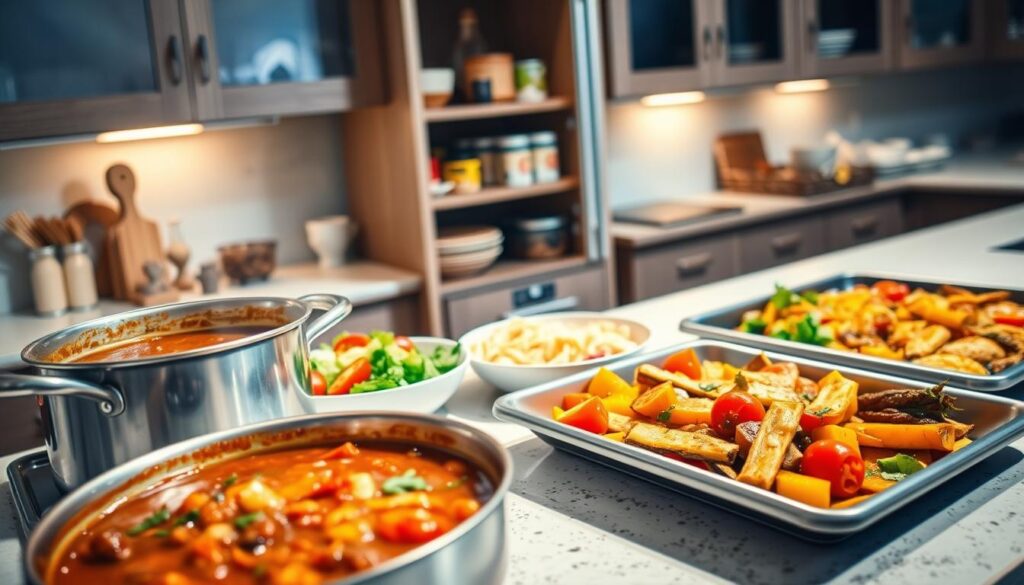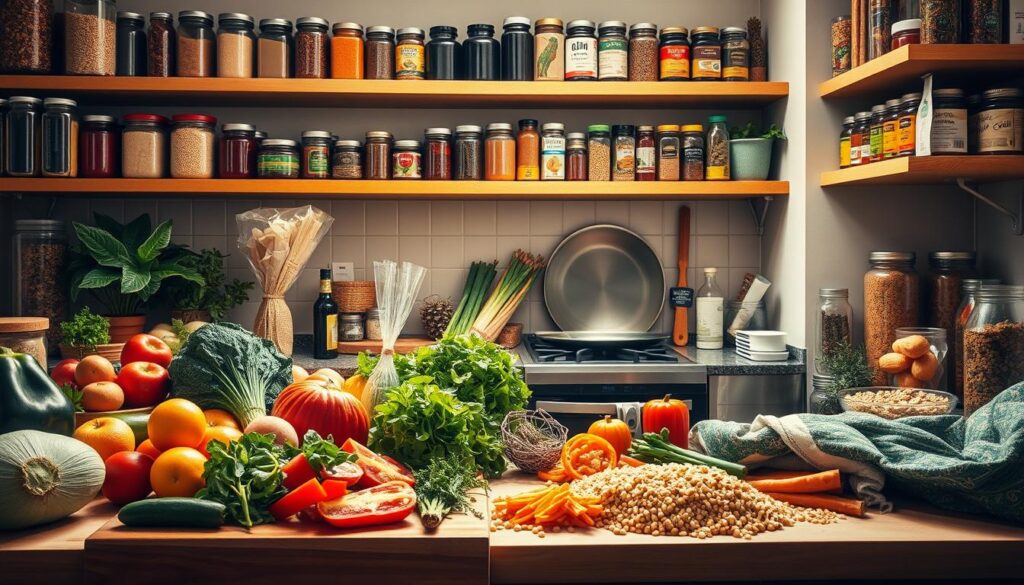Looking to save on grocery shopping? The $50 weekly grocery challenge is a smart way to do it. It helps you make delicious meals for your family without breaking the bank. By planning meals and shopping wisely, you can cut costs and waste less food.
With a bit of creativity, you can cook tasty meals for your family on a budget. The trick is to plan your meals, make a list, and stick to it. This way, you avoid buying things you don’t need and waste less food. In this article, we’ll dive into the $50 weekly grocery challenge. We’ll share tips on meal planning and budget-friendly shopping.
Introduction to the Challenge
The $50 weekly grocery challenge helps you manage your grocery budget and cook healthy meals. With a few simple tips, you can save money and cut down on waste. It’s perfect for busy parents or college students looking to cook delicious meals on a tight budget.
The $50 Grocery Challenge: What to Expect
Starting the $50 weekly grocery challenge means you’ll need to get creative with frugal cooking and find affordable recipes. To succeed, you must understand the challenge and what it entails. This includes having the right kitchen tools and knowing what meals you can make.
A well-stocked kitchen is key for frugal cooking. You’ll need a slow cooker, sharp knives, and various pots and pans. These tools help you make a variety of affordable recipes with your $50 budget.
Understanding the Basic Guidelines
Before you start, plan your meals and make a grocery list. Think about your food preferences and how many people you’ll be cooking for. This helps you stay within your budget and make the most of your $50.
Essential Kitchen Tools You’ll Need
- Slow cooker
- Set of sharp knives
- Variety of pots and pans
- Colander
- Can opener
Setting Realistic Expectations
Be realistic about what you can do with $50. You won’t be making fancy meals or buying expensive ingredients. Instead, focus on simple, affordable recipes that use what you already have. With a bit of creativity, you can make tasty meals without breaking the bank.
Smart Shopping Strategies for Maximum Savings
Smart shopping is crucial for budgeting for groceries. Plan your shopping trips and use coupons to save money. Shopping at discount stores or using cashback apps can also help. This way, you can stay within your $50 weekly budget.
For better grocery shopping, buy in bulk and plan meals around sales. Use unit prices to compare costs of different brands and sizes. Stores like Aldi and Lidl offer affordable prices on essentials like produce, meat, and dairy.

- Make a list and stick to it to avoid impulse buys
- Shop the perimeter of the store, where fresh produce and meats are typically located
- Use store loyalty programs to earn discounts and rewards
By using these smart shopping strategies, you can save money and make the most of your $50 weekly grocery budget.
Creating Your Weekly Meal Plan
When tackling the $50 weekly grocery challenge, meal planning is key. Planning meals ahead helps you use ingredients wisely and cuts down on waste. Start by thinking about what you like to eat and what’s in season and on sale.
A good weekly meal plan keeps you organized and focused. Here are some tips to begin:
- Plan your breakfast, lunch, and dinner meals for the week
- Make a list of the ingredients you need and stick to it
- Consider cooking meals in bulk and using leftovers to reduce waste
By following these tips and making a weekly meal plan, you can stretch your $50 budget. Enjoy healthy, tasty meals all week. Don’t forget to be flexible and adjust your plan as needed to stay within budget and use all your ingredients.
Budget Friendly Meals Your Family Will Love
It’s possible to cook for your family without spending a lot. You can make budget-friendly meals with a bit of creativity and planning. Using ingredients like beans, rice, and pasta is a smart way to save money.
Here are some tips for creating affordable recipes:
- Plan your meals around what’s on sale at the grocery store
- Use leftovers to create new meals
- Cook in bulk and freeze for later
Some great budget-friendly meals include slow-cooked stews, roasted veggies, and one-pot pasta. These dishes are not only cheap but also simple to prepare. You can also adjust them to fit your family’s preferences.

Cooking from scratch can also be a fun family activity. Get your kids involved in the kitchen. They can learn about different ingredients and cooking methods. It’s a great way to bond and learn together.
| Meal Idea | Ingredients | Cost |
|---|---|---|
| Spaghetti with Tomato Sauce | Spaghetti, canned tomatoes, ground beef, onions, garlic | $10 |
| Black Bean and Rice Bowl | Black beans, rice, diced tomatoes, shredded cheese, lettuce | $8 |
By using these tips and ideas, you can make tasty and affordable recipes for your family. Always plan ahead, shop smart, and cook from scratch to stretch your budget.
Maximizing Ingredients: Zero Waste Cooking
Reducing food waste and saving money starts with using all ingredients. Creative use of leftovers and proper storage can make a big difference. Start by using the oldest ingredients first in your kitchen.
This method stops food from going bad and cuts down on waste. Also, planning meals with what you already have helps avoid buying too much. This way, you don’t waste food or money.

Batch cooking and repurposing leftovers are great strategies. Cooking big batches saves ingredients and makes more meals. You can also turn last night’s dinner into tomorrow’s lunch or add leftover veggies to a new dish.
Reducing Food Waste Tips
- Plan your meals around what’s already in your fridge and pantry
- Use up leftover ingredients in creative ways
- Store food properly to prevent spoilage
- Implement a “first in, first out” policy in your kitchen
By using these tips, you can greatly reduce food waste and save money. It’s good for the planet and your wallet. Plus, it makes your meals more sustainable.
Seasonal Shopping for Better Deals
Planning meals around what’s in season can save you money. It also lets you enjoy fresher ingredients at lower prices. This way, you get the best deals on your groceries.
To get the most out of seasonal shopping, follow these tips:
- Check your local farmer’s market or grocery store to see what’s in season
- Plan your meals around the freshest ingredients available
- Adjust your shopping list accordingly to avoid wasting food and saving money
By using smart shopping strategies, you can stretch your grocery budget. You’ll enjoy delicious, fresh meals all year round.
Pantry Essentials for Budget Cooking
Having a well-stocked pantry is key to saving money on groceries. It lets you cook a variety of meals without spending a lot. Start by stocking up on basics like rice, beans, and pasta. These items can help you make everything from simple pasta dishes to bean and rice bowls.
It’s also important to build your spice collection on a budget. You don’t have to spend a lot to have a great spice rack. Look for spices in bulk and at discount stores for cheaper prices. Salt, pepper, and oregano are must-haves. They add flavor to many dishes, from soups to stir-fries.
To get the most out of your pantry, plan your meals and budget for groceries. Meal planning helps you avoid impulse buys and save money. It also helps you use up what you have, reducing waste and saving cash.
- Stock up on must-have staples like rice, beans, and pasta
- Build your spice collection affordably by buying in bulk and shopping at discount stores
- Plan your meals in advance to make the most of your pantry essentials and budget for groceries
By following these tips, you can build a great pantry and save money on groceries. A little planning and creativity can help you cook tasty meals without overspending.
Common Challenges and Solutions
Starting the $50 weekly grocery challenge can be tough. One big issue is price changes. To beat this, plan meals based on sales and adjust recipes as needed.
Dealing with dietary needs is another hurdle. Solutions for budget cooking include finding cheaper alternatives and being flexible with meals. For example, if you need gluten-free, look for affordable options or swap ingredients.
Getting everyone to agree on meals is key. Involve your family in planning to find meals they like. Some solutions for budget cooking are:
- Make a meal plan with everyone’s favorites
- Set a budget for each meal and stick to it
- Be open to new recipes and ingredients
Knowing these challenges and having plans can make the $50 weekly challenge a success.
Flexibility is the key to beating common challenges. With creativity and planning, you can find solutions for budget cooking that fit your family’s needs and stay within your $50 budget.
Conclusion: Making the $50 Challenge Work for You
The $50 weekly grocery challenge is a great way to save money and cut down on food waste. By using the tips from this article, you can make tasty, affordable meals for your family. It’s all about being flexible, creative, and open to trying new things.
When you start the $50 challenge, be ready to make changes. Prices can change, and your family’s tastes might shift. Stay flexible and don’t hesitate to try new recipes or ingredients. With practice, you’ll get better at stretching your $50 budget.
Staying committed is key. Celebrate your wins, learn from your losses, and enjoy the journey of finding ways to save on groceries. By making the $50 challenge a regular part of your week, you’ll save money and improve your cooking skills. Plus, you’ll help your family eat healthier.
FAQ
What is the $50 weekly grocery challenge?
The $50 weekly grocery challenge is a way to stretch your grocery budget. It helps you make delicious meals for your family. By planning meals, shopping smart, and using ingredients wisely, you can save money and cut down on food waste.
What essential kitchen tools do I need for the $50 grocery challenge?
For the $50 weekly grocery challenge, you’ll need a few key tools. A slow cooker, sharp knives, and storage containers for leftovers are essential. These tools help you cook efficiently and reduce waste.
How can I create a weekly meal plan on a $50 budget?
Planning your meals is key for the $50 grocery challenge. Think about your family’s tastes and dietary needs. Plan meals around seasonal foods and what’s on sale. This approach helps you use ingredients well and avoid waste.
What are some budget-friendly meal ideas my family will love?
Affordable meals for the $50 challenge include dishes with beans, rice, and pasta. Slow-cooked and roasted meals are also great options. Cooking from scratch and using leftovers can save you money.
How can I maximize my ingredients and reduce food waste?
To make the most of your ingredients and cut down on waste, follow a “first in, first out” policy. Batch cooking and creative use of leftovers are also helpful. Proper storage extends the life of your ingredients.
How can I adjust the $50 weekly grocery challenge for dietary restrictions or family preferences?
Adapting the $50 challenge for dietary needs or preferences can be tough. But it’s doable. Be flexible and adjust your meal plan as needed. This way, you can still make tasty, budget-friendly meals for everyone.



